Alternative names:The Large Olive Bulbul[1], Olive-brown Bulbul, 橄榄褐鹎[2],Merbah Belukar (Malay)[3], Nok Parawd see phlai yai (Thai)[4]
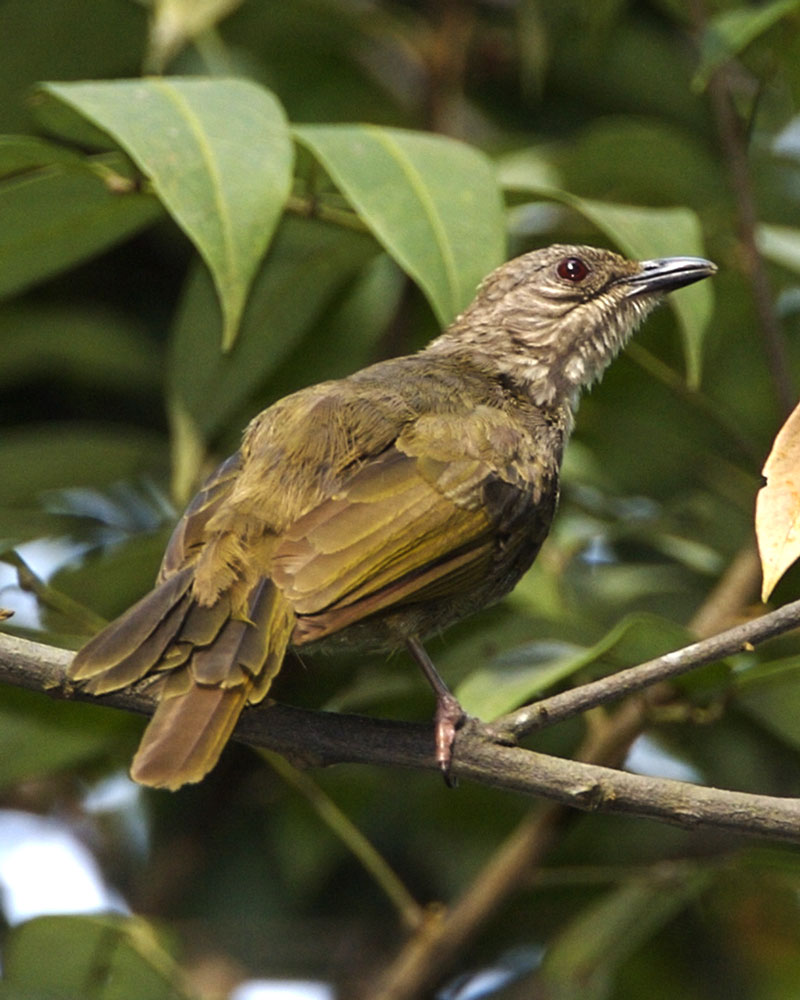 |
| An adult Olive-winged Bulbul. © Dr. L.K. Yap, under CC BY-SA 2.0. |
Table of Contents
Etymology
The generic name Pycnonotus is derived from Greek words puknos (πυκνός) – meaning clasped, thick or dense – and noton (νῶτον), which means “back”. The species epithet plumosus is Latin for “feathered”.Description
From Wells (2007) unless stated otherwiseA medium-sized brown bird with diagnostic olive-green wings commonly found in secondary forests and scrub[2]. This species is sexually monomorphic and is only seen singly, in pairs, or with young in a group of three[3]. In Singapore, the subspecies found is the nominate subspecies (P. plumosus plumosus).
Size and Weight Measurements
Size: 20 – 20.5cm[5]Weight: Males 28.0 – 32.0g, females 24.0 – 32.0g
Wing: Males 82 – 91 mm, females 80 – 88 mm, juveniles down to 75mm
Tail: Males 72.9 – 83.9 mm, females 70.0 – 81.0 mm
Bill: Males 16.3 – 17.5 mm, females 15.5 – 17.5 mm
Tarsus: Males 19.2 – 21.7 mm, females 19.1 – 20.6 mm
Adults
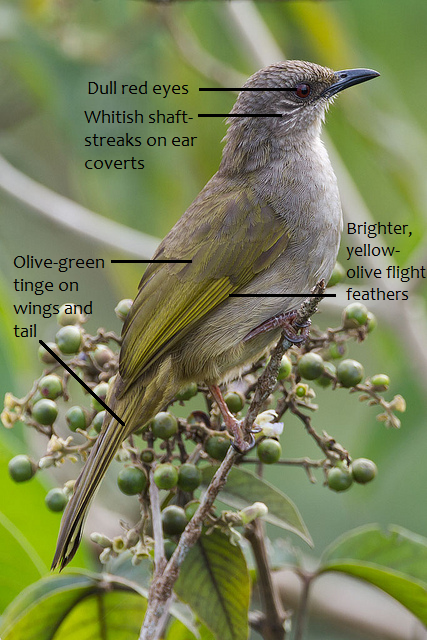 |
| An adult Olive-winged Bulbul with key diagnostic features highlighted. © Francis Yap. |
For information about parts of a bird, you can click here, or visit the website for more detailed diagrams and information.
Eye dull red, lores and rim of eyelids dark brown[4][6]. Crown brownish-grey, face clay grey, with olive-brown ear-coverts sporting whitish shaft-streaks starting below the eye[2][4][5]. Bill black and neck dark brown[1], with clay white chin and throat.
Breast and flanks olive-brown, belly clay white with a tawny tinge. Back, wings, and upper tail-coverts are dark brown with olive-green tinge, lower tail-coverts are light olive brown, rump slightly warmer brown. Tail is dark olive-green, with deep buff under-tail coverts[6]. Vent is dull yellow-brown[2]. Flight feathers are a brighter yellow-olive. Feet are brown[1].
An albino individual was previously reported from Singapore’s Central Catchment Nature Reserve woodland[4].
Juveniles
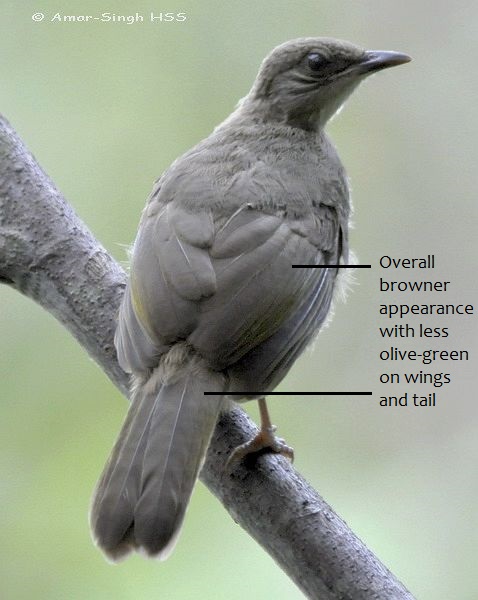 |
| A juvenile Olive-winged Bulbul with diagnostic features highlighted. © Amar-Singh HSS, permission pending. |
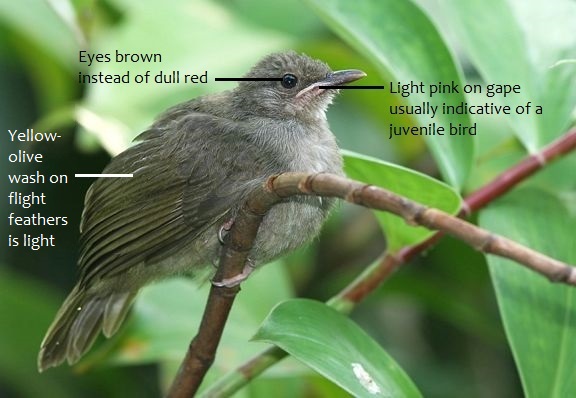 |
| Another juvenile Olive-winged Bulbul, presumably younger than individual in left photo. © Mervin Quah, permission pending. |
Compared to adults, juveniles appear browner overall, with less of the olive-green tinge seen on adults. Their eyes are brown instead of dull red; the whitish shaft-streaks on ear-coverts are also less obvious. They also sport weaker yellow-olive colouration on the flight feathers such that flight feathers are a duller green. Also lacks patterning on lower tail-coverts[5].
"Subspecies" Variation*
*Disclaimer: The validity of "subspecies" as ranks are still an area of debate. Population or intraspecific polymorphism would be an appropriate term for "subspecies variation" if you do not subscribe to the notion of "subspecies".
From Mees (1986)
- P. p. porphyreus: iris creamy-white, yellow, or orange (brown in juvenile) instead of dull red in nominate subspecies
- P. p. cinereifrons: forehead feathers fringed with pale grey, breast pale grey, belly light greyish-white, undertail-coverts olive-buff, remiges and rectrices duller fringes
- P. p. insularis: slightly larger than P. p. plumosus
- P.p. hutzi: upperparts slightly less olive than nominate subspecies, with underparts more grey and less yellow.
Diagnosis
P. plumosus is differentiated from other similar-looking bulbuls based on size, its whitish streaks on ear-coverts, and its diagnostic olive-green tinge to plumage and yellow-olive tinge to flight feathers.- Differentiated from Cream-vented Bulbul (P. simplex), Red-eyed Bulbul (P. brunneus), and Spectacled Bulbul (P. erythropthalmos) by yellow-green colour on wings and eye colour[1]. All three species lack the yellow-green wash on flight feathers and are more closely associated with the forest than P. plumosus. Additionally, P. simplex possesses a white eye-ring and P. erythropthalmos an orange eye-ring, which further distinguishes these species from P. plumosus.
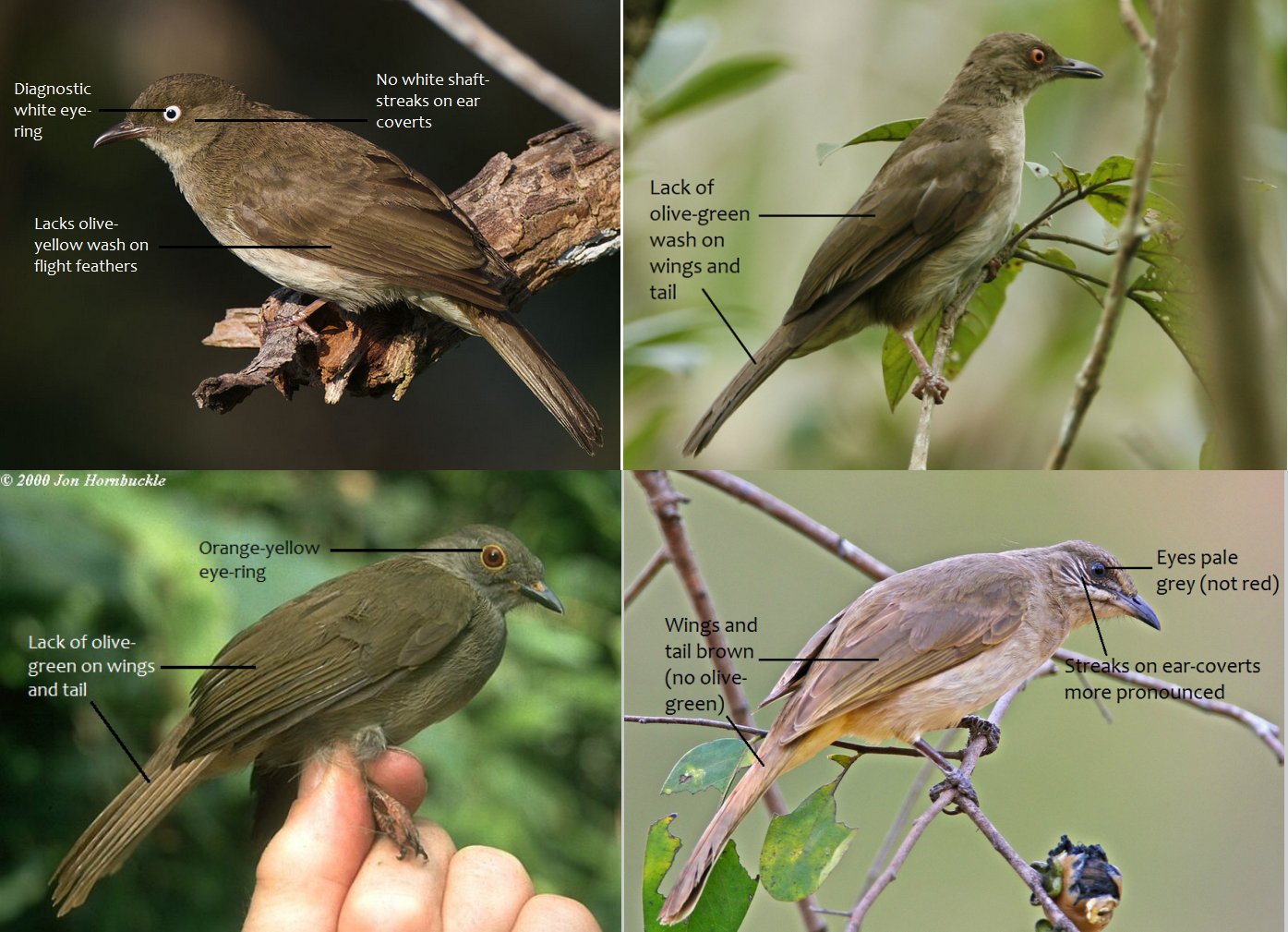 |
| From top-left, clockwise: Cream-vented Bulbul, Red-eyed Bulbul, Streak-eared Bulbul and Spectacled Bulbul showing features that distinguish them from the Olive-winged Bulbul. © Francis Yap; Dr. L.K. Yap, under CC BY-SA 2.0; Daniel Koh; Jon Hornbuckle respectively. Permission pending from the last two photographers. |
- Differentiated from Streak-eared Bulbul (P. blanfordi) by P. plumosus having dull-red eyes, less pronounced streaks on ear-coverts, yellow-olive tinge to wings, solid black bill and contrasting darker lores and eye region[5].
Habitat and Distribution
Habitat
This terrestrial, arboreal species inhabits a wide range of habitats, including forest edges, secondary regrowth and scrub, coastal and mangrove vegetation, degraded peatswamp forest and occasionally even parkland[2][4]. It is found less frequently in more heavily wooded areas[8], yet does not appear as frequently as the Yellow-vented Bulbul (P. goiavier) in more open areas such as lawns, parks and roads[1]. Usually keeps to the lower storeys of the vegetation, but will fly down low to feed on low fruiting trees or shrubs[2]. Inhabits the lowlands to c.500m above sea-level, with a pair once reported at 800m altitude[4].Distribution
A common resident that occurs and/or breeds from c. 12°30’N in Myanmar, Peninsula Thailand, Peninsula Malaysia (including many Malaysian islands), Singapore (including many offshore islands), Sumatra, Borneo, Java and Palawan[3]. BirdLife International (2013) estimates its range of occurrence (breeding/resident) to be approximately 1,520,000km2.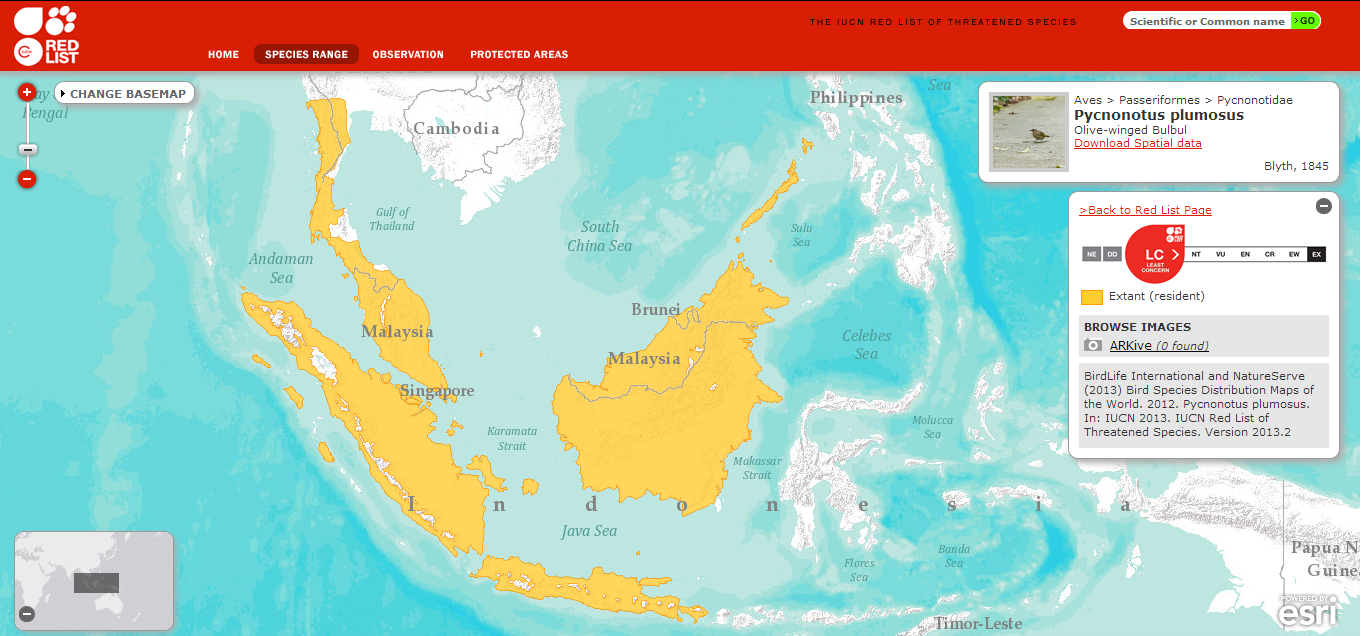 |
| Distribution map of the Olive-winged Bulbul in general. © The IUCN Red List of Threatened Species™. |
"Subspecies" Distribution*
*Disclaimer: The validity of "subspecies" as ranks are still an area of debate. "Distribution of different colour/size morphs" would be an alternative term if you do not subscribe to the notion of "subspecies".From Clements et al. (2013)
- P. p. plumosus: Southern Myanmar, Southern Thailand, Malay Peninsula, Singapore, Eastern Sumatra, Java, Bali and Western and Southern Borneo
- P. p. porphyreus: Western Sumatra, Nias, Batu, Banyak islands
- P. p. chiroplethis: Anambas Islands (South China Sea)
- P. p. billitonis: Western and Southern Borneo and Belitung Island
- P. p. hutzi: Northern and Eastern Borneo
- P. p. hachisukae: North-Eastern Borneo Islands (including Banggai); Cagayan Sulu (South-Western Philippines)
- P. p. sibergi: Bawean Island (Java Sea)
Google Map of Population Distribution:
Biology
Songs and Calls
The Olive-winged Bulbul's song is a simple repeated chirruping "whip wi-wiu wu-wurri’i", but can include many variations such as stuttered components[4]. Calls include a throaty "whip-whip…" and "wrrh wrrh wrrh…"[5]. These songs and calls are somewhat similar to that of the Yellow-vented Bulbul (P. goiavier), being throaty and melodious, but are more clipped and sharply phrased than the latter species’[8].To compare the two species' songs, click the play buttons below:
The calls and songs of P. plumosus are frequently issued, especially during the dawn chorus, and usually from a concealed location[11][12]. To listen to more P. plumosus songs and calls, click HERE.
Diet
This species is generally described as a frugivore, feeding on small fruits and berries, but will also take small invertebrate prey such as caterpillars and beetles[8][13]. Fruit taken include the figs of Ficus microcarpa, and F. trichocarpa, fruit of Gynotroches axillaris and Campnospermum auriculatum (Anacardiaceae), Acacia mangium seed arils and Dillenia suffruticosa seeds[4][14]. Due to this, P. plumosus plays an important role as a seed disperser in forests[13]. Their mixed diet of fruit and insects has also been postulated as an explanation for their small individual range sizes, supposedly because they need not travel all the time to search for specific food sources[15].Movement and Migration
This species is non-migratory[16]. A preliminary radio-tracking study to establish their ranges by Peh and Ong (2002) further showed that the species is sedentary and non-territorial, as individual birds’ ranges overlapped greatly with those of conspecifics, as well as individuals of other species such as the Cream-vented Bulbul (P. simplex). The home range size was estimated to be 0.29-7.23 ha during the breeding season[17].Reproduction
From Wells (2007) unless stated otherwiseOlive-winged Bulbuls breed from January to July (late pairs till August)[3][5], with breeding season peaking between March and June[8]. A minimum of two adults builds the nest and tends fledglings, with possibility of helpers at the nest [undocumented]. The nest (external diameter 7 cm) is cup-shaped and deep, loosely constructed of dead leaves, sticks, and stems, and lined with fibre and some grass. Nests are usually built in shrubs and saplings 1.5 to 13m above the ground, but mostly nearer to the ground. Recorded nesting sites include the “hollowed top of a nipah palm frond stub; a stemless, forest-edge bertam palm; screw-palm clump; scrambling ferns; fork in a low bush; and fork of a rubber tree”.
Usually two eggs (22.4 x 17.8 mm) are laid per nest, and resemble those of the Yellow-vented Bulbul (P. goiavier)[5]. They are however darker in colour, with the spots being larger and redder and mixed with some blue-grey blotches[5]. Each brood usually produces one or two fledglings.
Moult
Wing-moult of this species is rare during December – February, with low incidence in March and April. Such moulting increases drastically in May and June to July – September, then regresses sharply in October – November[4].
Population and IUCN Conservation Status
From BirdLife International (2012) unless stated otherwiseIUCN Red List Status: Least Concern (LC) (2004, 2008, 2009)
This species has a stable population trend and as such does not meet the population trend criterion (“>30% decline over ten years or three generations”) for a Vulnerable IUCN status. It also does not cross the population size criterion (“<10,000 mature individuals with a continuing decline estimated to be >10% in ten years or three generations, or with a specified population structure”), as it is described to be abundant throughout its large range. For example, in Singapore, Yong et al. (2013) rates its abundance as “Common, very likely (50-75%) to occur in preferred habitat”, while it is resident in many other areas across its distribution[3]. If anything, this species seems to have benefitted from deforestation and human impact on primary vegetation[4].
Taxonomy and Type Locations
From BirdLife International (2012). Locations of type specimens are indicated in brackets – from Dickinson et al. (2002).Species: Pycnonotus plumosus Blyth, 1845i
- "Subspecies"*: Pycnonotus plumosus plumosus Blyth, 1845 (ZSI?)ii
- "Subspecies": Pycnonotus plumosus porphyreus Oberholser, 1912 (USNM)
- "Subspecies": Pycnonotus plumosus chiroplethis Oberholser, 1917 (USNM)
- "Subspecies": Pycnonotus plumosus billitonis Chasen, 1935 (RMNH)
- "Subspecies": Pycnonotus plumosus hutzi Stresemann, 1938 (ZMB)
- "Subspecies": Pycnonotus plumosus hachisukae Deignan, 1952 (BMNH)
- "Subspecies": Pycnonotus plumosus sibergi Hoogerwerf, 1965 (MZB)
ZSI: Zoological Survey of India, Calcutta. BMNH: The Natural History Museum, Tring - formerly the British Museum (Natural History). RMNH: National Museum of Natural History, Leiden - formerly Rijksmuseum van Natuurlijke Historie. MZB: Museum Zoologicum Bogoriense, Cibinong, Nr. Bogor. ZMB: Zoologisches Museum, Berlin. USNM: United States National Museum, Washington DC.
Unfortunately, no original description nor photograph of the species holotype can be found online. However, descriptions and photographs of some of the "subspecies" type specimens can be found HERE.
The "subspecies" Pycnonotus plumosus hachisukae was Pycnonotus p. insularis previously, but was renamed hachisukae[20]. This was due to the genus Andropadus being reduced to a "subgenus" of Pycnonotus, and the name insularis being occupied by Andropadus importunus insularis.
Another "subspecies", Pycnonotus plumosus cinereifrons (Tweeddale, 1878) also used to exist, residing in Palawan, West Philippines. However, phylogenetic analyses on Philippine bulbuls by Oliveros and Moyle (2010) showed a lack of monophyly and a comparatively large genetic divergence between P. p. cinereifrons and its sister taxon P. simplex. This, combined with small morphological differences, compelled the authors’ recognition of the Palawan population as a distinct, endemic species from its Borneo counterpart P. plumosus. To date, most authors have accepted this change has been accepted and Pycnonotus plumosus cinereifrons is now the Ashy-fronted Bulbul (Pycnonotus cinereifrons).
Phylogeny
A recent study on bulbuls (Aves: Pycnonotidae) using ND2, ND3 (second and third subunits of mitochondrial nicotinamide adenine dinucleotide dehydrogenase) and Fib7 (seventh intron of the nuclear gene Beta-fibrinogen) placed P. plumosus sister to P. brunneus (Asian Red-eyed Bulbul)[22].
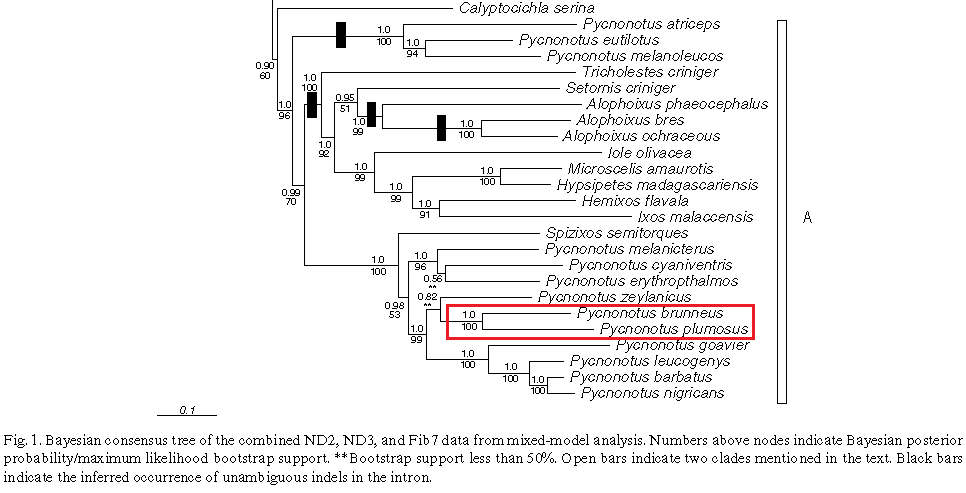 |
| Part of the consensus tree showing Pycnonotus plumosus as sister to Pycnonotus brunneus (red rectangle). Figure from Moyle and Marks, (2006). |
Another study by Lim et al. (2011) using samples from peninsula Malaysia (PEN), western Borneo (WB) and northeastern Borneo (NEB) sequenced the NADH2 gene and found a genetic break between Peninsula Malaysian and Bornean populations, with either population forming a well-supported clade (see figure below). The estimated divergence time of the two populations predated 21 kya (thousand years ago), suggesting that the birds did not intermix extensively during the Last Glacial Maximum (about 20 kya), perhaps due to the presence of habitat barriers.
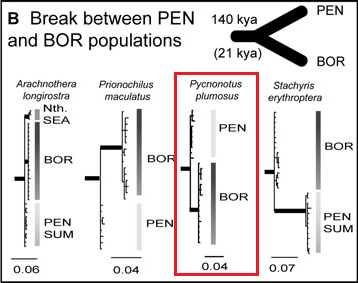 |
| Figure showing break between P. plumosus Peninsula Malaysian and Bornean populations (red rectangle). "Each tree is a Bayesian majority-rule consensus tree, and each branch tip represents one individual. Thickened branches represent Bayesian posterior or ML bootstrap nodal support of >0.90 or >75%, respectively. Scale bar units = substitutions/site." Figure from Lim et al., (2011). |
Last but not least, numerous genes of the Olive-winged Bulbul have been sequenced and the results deposited in databases like GenBank and BOLD Systems. These include the barcoding gene COI, as well as ND2, ND3, CYTB, Fib5, MUSK and 16S rRNA genes. For the full list of sequences in GenBank, click HERE. Additionally, several sequences for some of the "subspecies" have also been deposited. Click this LINK to view the GenBank summary records for the species as well as the relevant "subspecies" - you can then navigate to the respective "subspecies" nucleotide sequences by clicking the "Direct Links" under "Nucleotide" on each organism's page.
Additional Links
http://avibase.bsc-eoc.org/species.jsp?avibaseid=09CBDAE2D33A38C8http://www.birdlife.org/datazone/speciesfactsheet.php?id=7208
http://eol.org/pages/919968/overview
http://ibc.lynxeds.com/species/olive-winged-bulbul-pycnonotus-plumosus
References
[1] Bucknill, S. J.A. and F.N. Chasen, 1990. Birds of Singapore and South-east Asia. Graham Brash, Singapore.
[2] Yong, D. L., K. C. Lim & T. K. Lee, 2013. A Naturalist’s Guide to the Birds of Singapore. John Beaufoy Publishing, Oxford. 176 pp.
[3] Davison, G. W. H. & C. A. Yeap, 2010. A Naturalist's Guide to the Birds of Malaysia and Singapore. Beaufoy Books, Oxford. 176 pp.
[4] Wells, D. R., 2007. The birds of the Thai-Malay Peninsula: Covering Burma and Thailand south of the eleventh paralle, Peninsular Malaysia and Singapore. Christopher Helm, London.
[5] Robson, C., 2008. A Field Guide to the Birds of South-East Asia. New Holland, London. 544 pp.
[6] Davison, G.W.H. and C.Y. Fook, 1995. A Photographic Guide to Birds of Peninsular Malaysia and Singapore. New Holland Publishers, London.
[7] Mees, G. F., 1986. A list of the birds recorded from Bangka Island, Indonesia. Zoologische verhandelingen, 232: 3-176.
[8] Hails, C., F. Jarvis and J. Perkins, 1987. Birds of Singapore. Times Editions, Singapore.
[9] BirdLife International, 2013 Species factsheet: Pycnonotus plumosus. Downloaded from http://www.birdlife.org on 12/11/2013.
[10] Clements, J. F., T. S. Schulenberg, M. J. Iliff, B.L. Sullivan, C. L. Wood, and D. Roberson. 2013. The eBird/Clements checklist of birds of the world: Version 6.8. Downloaded from http://www.birds.cornell.edu/clementschecklist/download/
[11] Strange, M., 2002. A Photographic Guide to the Birds of Southeast Asia: Including the Philippines and Borneo. Periplus Editions, Hong Kong. 398 pp.
[12] Wang, L. K., D. C. J. Yeo, K. K. P. Lim & S. K. Y. Lum (eds.), 2012. Private Lives : An exposé of Singapore's rainforests. Raffles Museum of Biodiversity Research, Singapore. 298 pp.
[13] Whittaker, R. J. and S. H. Jones, 1994. The role of frugivorous bats and birds in the rebuilding of a tropical forest ecosystem, Krakatau, Indonesia. Journal of Biogeography, 21(3): 245-258.
[14] Briffett, C., 1993. The Birds of Singapore. Oxford University Press, New York. 104 pp.
[15] Wong, M., 1986. Trophic organization of understory birds in a Malaysian dipterocarp forest. The Auk, 103(1): 100-116.
[16] Kamtaeja, S., N. Sitasuwan, S. Chomdej, A. Jatisatienr and D.J. Mennill, 2012. Species-distinctiveness in the vocal behaviour of six sympatric bulbuls (genus Pycnonotus) in South-East Asia. Emu, 112(3): 199-208.
[17] Peh, K. S. H. and L. Ong, 2002. A preliminary radio-tracking study of the ranging behaviour of Olive-winged Bulbul (Pycnonotus plumosus) and Cream-vented Bulbul (P. Simplex) in a lowland secondary rainforest in Singapore. The Raffles Bulletin of Zoology, 50(1): 251-256.
[18] BirdLife International, 2012. Pycnonotus plumosus. In: IUCN 2013. IUCN Red List of Threatened Species. Version 2013.1. <www.iucnredlist.org>. Downloaded on 13 November 2013.
[19] Dickinson, E., R. Dekker, S. Eck and S. Somadikarta, 2002. Systematic notes on Asian birds. 26. Types of the Pycnonotidae. Zoologische Verhandelingen, 340: 115-160.
[20] Deignan, H.G., 1952. The nomenclature of certain bulbuls (Pycnonotus): A reconsideration. The Auk, 69(4): 463-465.
[21] Oliveros, C. H. and R. G. Moyle, 2010. Origin and diversification of Philippine bulbuls. Molecular Phylogenetics and Evolution, 54(3): 822-832.
[22] Moyle, R.G. and B.D. Marks, 2006. Phylogenetic relationships of the bulbuls (aves: Pycnonotidae) based on mitochondrial and nuclear DNA sequence data. Molecular Phylogenetics and Evolution, 40(3): 687-695.
[23] Lim, H.C., M.A. Rahman, S.L. Lim, R.G. Moyle and F.H. Sheldon, 2011. Revisiting Wallace's haunt: Coalescent simulations and comparative niche modeling reveal historical mechanisms that promoted avian population divergence in the Malay Archipelago. Evolution, 65(2): 321-334.
Notes
iPycnonotus plumosus plumosus (Blyth, 1845) P[ycnonotus] plumosus Blyth, 1845, J. As. Soc. Bengal 14: 567. Singapore.
iiDickinson et al. (2002) states the location of the type specimen uncertainly as the ZSI (Zoological Survey of India) museum.